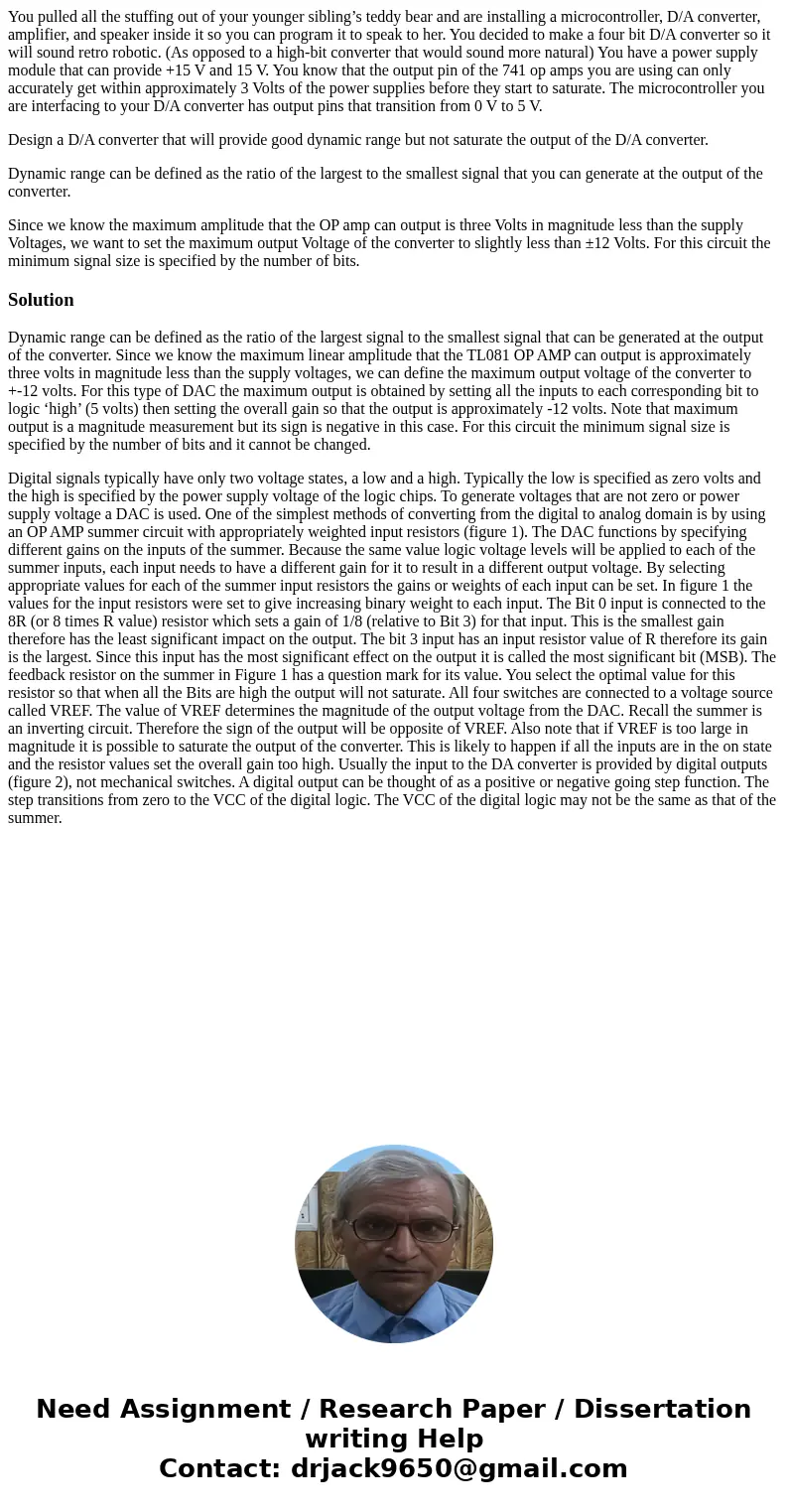You pulled all the stuffing out of your younger siblings ted
You pulled all the stuffing out of your younger sibling’s teddy bear and are installing a microcontroller, D/A converter, amplifier, and speaker inside it so you can program it to speak to her. You decided to make a four bit D/A converter so it will sound retro robotic. (As opposed to a high-bit converter that would sound more natural) You have a power supply module that can provide +15 V and 15 V. You know that the output pin of the 741 op amps you are using can only accurately get within approximately 3 Volts of the power supplies before they start to saturate. The microcontroller you are interfacing to your D/A converter has output pins that transition from 0 V to 5 V.
Design a D/A converter that will provide good dynamic range but not saturate the output of the D/A converter.
Dynamic range can be defined as the ratio of the largest to the smallest signal that you can generate at the output of the converter.
Since we know the maximum amplitude that the OP amp can output is three Volts in magnitude less than the supply Voltages, we want to set the maximum output Voltage of the converter to slightly less than ±12 Volts. For this circuit the minimum signal size is specified by the number of bits.
Solution
Dynamic range can be defined as the ratio of the largest signal to the smallest signal that can be generated at the output of the converter. Since we know the maximum linear amplitude that the TL081 OP AMP can output is approximately three volts in magnitude less than the supply voltages, we can define the maximum output voltage of the converter to +-12 volts. For this type of DAC the maximum output is obtained by setting all the inputs to each corresponding bit to logic ‘high’ (5 volts) then setting the overall gain so that the output is approximately -12 volts. Note that maximum output is a magnitude measurement but its sign is negative in this case. For this circuit the minimum signal size is specified by the number of bits and it cannot be changed.
Digital signals typically have only two voltage states, a low and a high. Typically the low is specified as zero volts and the high is specified by the power supply voltage of the logic chips. To generate voltages that are not zero or power supply voltage a DAC is used. One of the simplest methods of converting from the digital to analog domain is by using an OP AMP summer circuit with appropriately weighted input resistors (figure 1). The DAC functions by specifying different gains on the inputs of the summer. Because the same value logic voltage levels will be applied to each of the summer inputs, each input needs to have a different gain for it to result in a different output voltage. By selecting appropriate values for each of the summer input resistors the gains or weights of each input can be set. In figure 1 the values for the input resistors were set to give increasing binary weight to each input. The Bit 0 input is connected to the 8R (or 8 times R value) resistor which sets a gain of 1/8 (relative to Bit 3) for that input. This is the smallest gain therefore has the least significant impact on the output. The bit 3 input has an input resistor value of R therefore its gain is the largest. Since this input has the most significant effect on the output it is called the most significant bit (MSB). The feedback resistor on the summer in Figure 1 has a question mark for its value. You select the optimal value for this resistor so that when all the Bits are high the output will not saturate. All four switches are connected to a voltage source called VREF. The value of VREF determines the magnitude of the output voltage from the DAC. Recall the summer is an inverting circuit. Therefore the sign of the output will be opposite of VREF. Also note that if VREF is too large in magnitude it is possible to saturate the output of the converter. This is likely to happen if all the inputs are in the on state and the resistor values set the overall gain too high. Usually the input to the DA converter is provided by digital outputs (figure 2), not mechanical switches. A digital output can be thought of as a positive or negative going step function. The step transitions from zero to the VCC of the digital logic. The VCC of the digital logic may not be the same as that of the summer.

 Homework Sourse
Homework Sourse